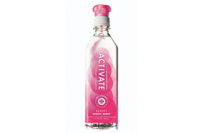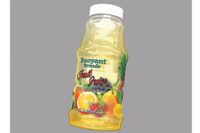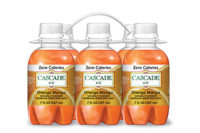Closures play a variety of roles in the beverage market








Although situated at the top of almost every beverage package, caps and closures might not be a top-of-mind factor for consumers when thinking about packaging. Nonetheless, they still play many important roles when it comes to packaging and marketing including providing a safe, hygienic seal as well as offering differentiated shelf presence.
As the world of packaging continues to evolve, more cap and closure options are becoming available to beverage companies, each with its own benefits and use occasions.
“Many consumers prefer flat caps because the flow rate and drinking experience is more like drinking from a glass than a sports cap,” explains Jane Haywood-Rollins, global marketing services manager of Closure Systems International (CSI), Indianapolis. “Sports caps are often the closure of choice for on-the-go consumers in a car or gym or [for] active schoolchildren because of their portability, ease of use without having to remove the cap, and spill resistance.”
Beyond these characteristics, consumers desire resealability for larger packaging sizes that are not likely to be consumed in one sitting, Haywood-Rollins notes.
As part of this preference, Northfield, Ill.-based Kraft Foods Inc.’s Capri Sun brand launched a limited-edition 11.2-ounce resealable Capri Sun Big Pouch with a twist-off cap in 2012, which allows consumers to enjoy the beverage in multiple sittings in a way they cannot with the smaller pouches, the company says.
For both larger and smaller packages, customers and consumers expect caps to provide good seal properties to protect the integrity and freshness of the product, Haywood-Rollins adds. CSI’s one- and two-piece lightweight solutions for carbonated and non-carbonated beverages respond to this expectation by delivering excellent sealing and venting in order to provide good performance, sustainability and consumer safety, she says.
Caps and closures also can be used to create a differentiated shelf presence or enhance branding. Special inks and varnishes can be applied to closures to draw consumer attention, says Sheila Heath, director of marketing for Crown Closures Americas, Philadelphia. Printing also can be added to caps for additional messaging, she adds.
“The skirt of the closure is an underused but powerful place for brands to communicate key messages to consumers,” Heath says. “Another option is to print messages under the cap to increase consumer engagement. This space is ideal for codes and special messages for promotions and contests or to communicate additional product information.”
Safety is key
Consumer packaged goods companies continue to keep safety and tamper-evident seals in mind for consumer protection.
Tamper-evident caps give visual, audible and tactile indications of whether a package is being opened for the first time or not, CSI’s Haywood-Rollins says.
Naperville, Ill.-based Portola Packaging Inc. creates stock and custom tamper-evident caps for dairy, juice and other beverages for this purpose, says Roy Robinson, vice president of business development. The company offers several different caps to meet both consumer safety and other material needs. For example, its 38-mm DBJ drop-band closure, which meets U.S. Food and Drug Administration 19 P PMO-19 tamper-evident guidelines, also is lightweight to reduce material, he says. The cap is compatible with high-density polyethylene (HDPE) and polyethylene terephthalate (PET) neck finishes, and its tamper-evident band remains on the bottle after opening to more clearly indicate previous opening, he adds.
In addition to safety prior to product use, some caps offer hygienic options to minimize germs during consumption. Aptar Food & Beverage, Crystal Lake, Ill., offers flip-top caps, such as its Original and 1881 Lite Original sport cap products that allow for one-handed opening and require the consumer to touch only the outer cap instead of the spout, thus minimizing the contact between any germs on their hands and the closure system, says Florent Gras, regional market development director of beverages for North America. Both products are easy to open and close, feature an active hinge that flips the upper cap back 170 degrees for easy drinking, and are available with a recyclable SimpliSqueeze silicone valve to make the cap spill-proof, the company says.
The power is in the cap
Caps also are being used to add value to a liquid product. Interactive caps or dosing caps, such as those featured in products like H2M Beverage LLC’s 989 water, Karma Culture LLC’s Karma Wellness Water, The Rising Beverage Co.’s Activate water and New York Spring Water Inc.’s VBlast water, were voted the No. 3 most innovative packaging design in Beverage Industry’s Best Packages of 2012 survey.
Dosing caps are designed to separate ingredients, such as vitamins, minerals and other supplements, from a beverage during storage and transportation. This separation keeps the ingredients fresh and allows them to be a more potent ingredient in the mix.
Responding to growing market interest in these dosing caps, Deerfield, N.H.-based PowerCap - Liquid Health Labs Inc. offers both push- and twist-style interactive capping solutions. Its PowerCap Push technology, which is available in 28-, 38- and 43-mm Fitness Cap styles, allows the user to add ingredients to the beverage by pushing on the cap. The two-piece cap design holds 6 cc of enhancing ingredients and has a sleek, slender and easy-to-push design, the company says. Its PowerCap Twist, which is available in 26.7-, 28-, 30- and 43-mm sizes as well as a Sports Cap style, can release 5 cc of ingredients into a beverage with a twist of the cap. The company also plans to launch customized large-dose offerings of both cap styles this year. “Our brand owners [that are] marketing products are seeking caps that are intuitive [and] easy-to-use/open with pricing that makes the project commercially viable,” says Derek Hopkins, president and chief executive officer. “The expectation is that closures hold enough ingredients, flow nicely when released and are user friendly enough for consumers to keep buying and enjoying.”
Customers also expect sustainable options from dosing caps, he says. To accommodate this, PowerCap uses HDPE and polypropylene (PP) plastics, which are recyclable, and manufactures two-piece caps with limited materials and parts to minimize cost while still ensuring quality, he says.
In addition, the packaging industry in general is always looking for innovation. Responding to the continued growth in the on-the-go market, PowerCap released its PowerCap Universal, which allows consumers to convert any beverage into a fun, interactive experience, Hopkins says. The 4-cc dosing cap is made to fit on almost any bottled water and can be sold alone or in multi-packs and then placed on a separate bottle by the consumer to enhance the beverage, Hopkins says. This capping option gives consumers the option to customize their beverages and also offers savings for beverage manufacturers and retailers, he says.
“Being able to sell beverages without shipping water is a great profit center for retailers, direct marketers and Internet-based businesses,” Hopkins says. “The health and wellness market continues to grow, and PowerCap technology is expanding the fortified beverage market by allowing [the use of] ingredients not normally used in mainstream beverages due to cost of ingredients, stability or solubility issues.”
As the fortified beverage market continues to grow, Hopkins expects dosing caps to become more well-known and accepted by consumers. “The dosing cap category really is starting to emerge with some real players in the market now, and I think that in 2013 it will really start to establish a decent footprint in the supermarkets and in retail, and then the private label store brands will start to get behind it, giving it even more awareness,” he says.
No bottle opener? No problem
Even though screw-top and pry-off crowns dominate the bottled beer market, Carrollton, Texas-based World Bottling Cap LLC offers a twist on these standard approaches with its Easy Pull Bottle Cap (EPBC).
“The EPBC uses the same material as a regular bottle cap and opens very simply by pulling a ring attached to the top, which releases the cap from the bottle,” explains Abe Frishman, president of World Bottling Cap. “The ring is attached to the cap by a rivet similar to the ring on the top of a can of soup. The easy release of the cap is expedited by the use of a patented design of score lines on the crown.”
The crown is made to maintain the quality of the product in the bottle and also prevent safety issues during opening, Frishman says. Plus, the pull-ring is tamper-evident for added protection, he says.
“Convenience is the key for the consuming public,” Frishman says, citing results from the company’s studies and focus groups for the EPBC. “The ability to open a bottle without the need for a bottle opener (never around when you need one) and eliminating the difficulties inherent in opening a twist-off cap are highly desirable to consumers.”
The EPBC also features a bio-degradable inner liner for enhanced recyclability and can be printed with thermochromic ink on the ring or any other surface area to indicate when the beverage is cold, Frishman adds.
Going synthetic
According to London-based Wine Intelligence’s report “Closures Report USA,” the wine consumption market remains divided on the preferential closure for this beverage category. Of the 136 million wine drinkers in the United States, 66 percent say they prefer natural cork stoppers because of their traditional use in the industry and association with quality wines and formal occasions, the report states.
However, this traditional favorite has the ability to cause issues like cork taint, says CSI’s Haywood-Rollins. A study by San Mateo, Calif.-based Merrill Research on behalf of Zebulon, N.C.-based Nomacorc also found that one-half of survey respondents reported having difficulty removing natural corks from bottles.
To solve these problems, synthetic corks offer an alternative to natural corks. For example, Nomacorc’s Select Series of synthetic corks, which are made of food-grade polyethylene, have a visual appearance and texture designed to be as close as possible to natural cork while offering a solution that is easy to extract from and reinsert into the bottle, says Katie Myers, global manager of public relations for Nomacorc. The Select 100, Select 300, Select 500 and Select 700 synthetic closures also are designed to offer an optimal wine ingress rate to preserve the wine and its flavor and aroma profiles and reduce bottle-to-bottle variation, she adds.
According to Wine Intelligence, 24 percent of U.S. wine consumers say they like buying bottles with synthetic corks. This closure is especially popular with the 25- to 34-year-old consumer age group, which associates the closure option with a beverage that is suitable for relaxing, informal occasions.
Another wine closure option, screw caps, has shown significant growth in the past year, Wine Intelligence reports. Twenty-two percent of U.S. wine consumers say they like buying screw-cap wines, up from 19 percent in March 2011, which shows that these closures are making a slow but steady advance toward popular acceptance in the market, the association adds. However, some consumers still associate the screw caps in the wine market with lesser quality, the report notes. In light of this, Wine Intelligence expects that screw cap wines might not become mainstream in the near future but are more likely to hit that milestone in the next five to 10 years. BI
Looking for a reprint of this article?
From high-res PDFs to custom plaques, order your copy today!











